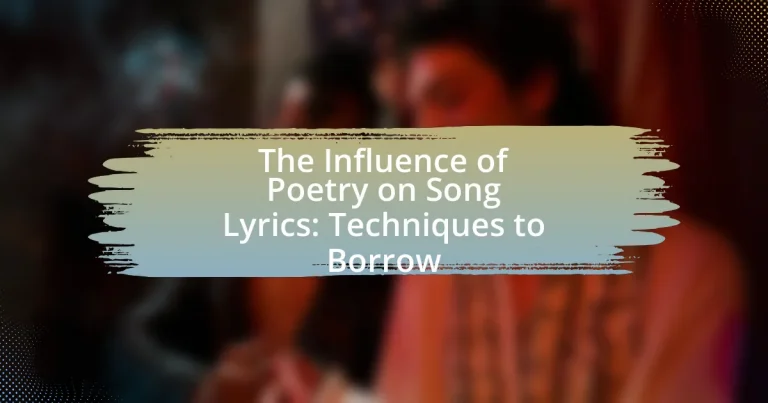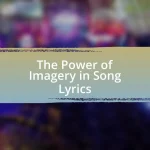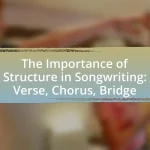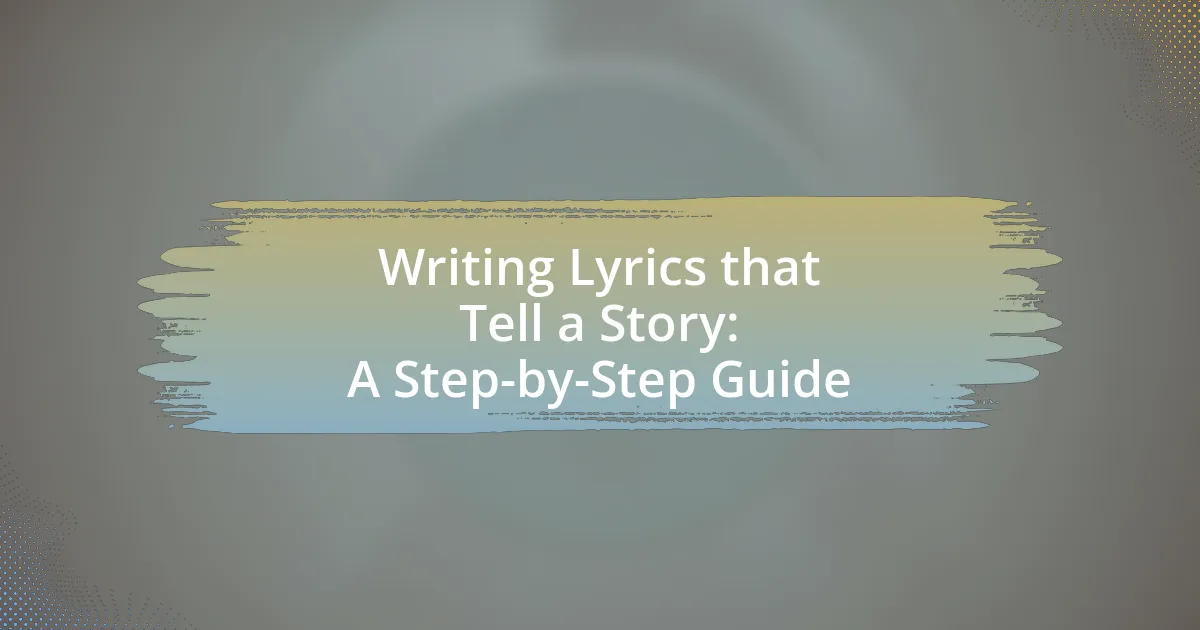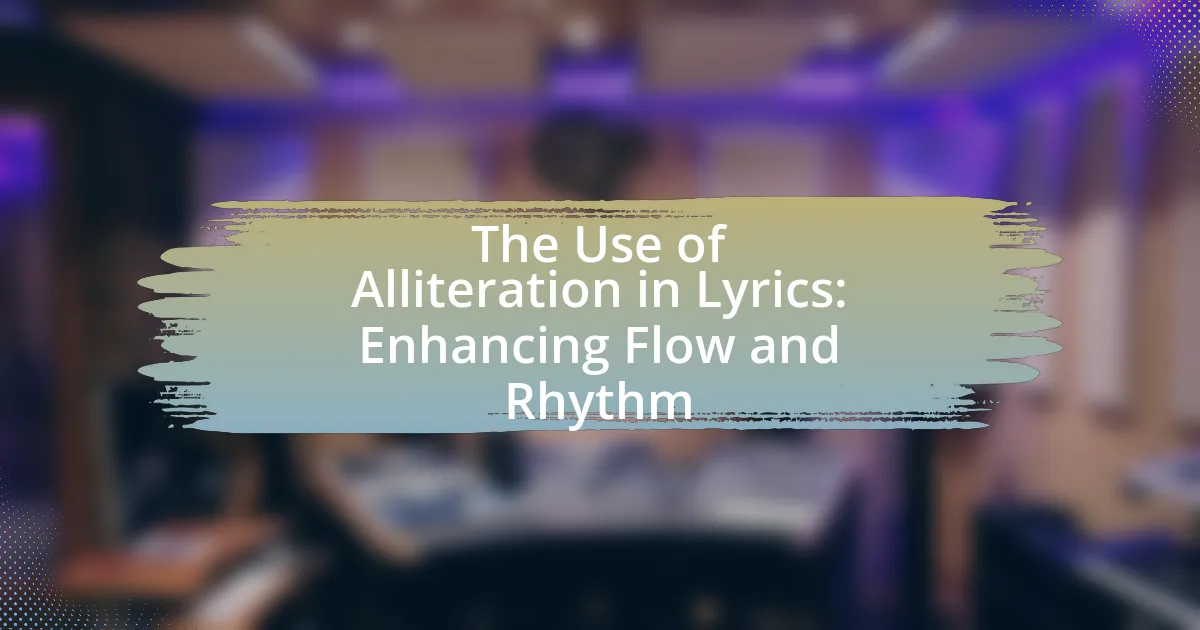The article examines the significant influence of poetry on song lyrics, highlighting how poetic techniques such as imagery, metaphor, and rhyme enhance the emotional depth and lyrical quality of music. It discusses the historical connections between poetry and song, the common poetic devices used in songwriting, and the ways in which cultural contexts shape lyrical themes. Additionally, the article provides practical tips for songwriters on incorporating poetic elements into their work, emphasizing the benefits of blending poetry with music to create more engaging and impactful songs.
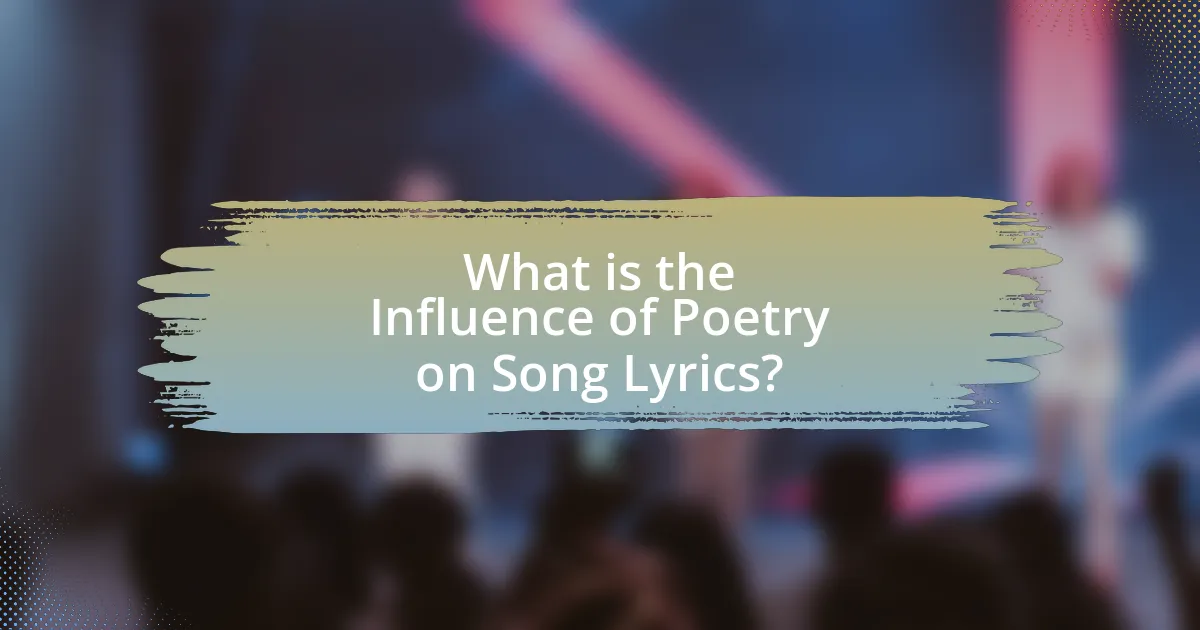
What is the Influence of Poetry on Song Lyrics?
Poetry significantly influences song lyrics by providing a rich framework of imagery, metaphor, and emotional depth. Songwriters often draw upon poetic techniques such as rhyme, meter, and symbolism to enhance the lyrical quality of their music. For instance, Bob Dylan’s use of vivid imagery and complex themes in his lyrics mirrors the style of modernist poets like T.S. Eliot, demonstrating how poetic elements can elevate the storytelling aspect of songs. Additionally, the lyrical structure in many popular songs reflects traditional poetic forms, showcasing the seamless integration of poetry into music. This interplay not only enriches the listening experience but also allows for deeper emotional connections with the audience.
How does poetry shape the themes in song lyrics?
Poetry shapes the themes in song lyrics by employing literary devices such as metaphor, imagery, and rhythm, which enhance emotional expression and narrative depth. These devices allow songwriters to convey complex feelings and ideas succinctly, often drawing on the rich tradition of poetic forms. For instance, Bob Dylan’s use of vivid imagery and metaphor in songs like “Blowin’ in the Wind” reflects the poetic influence, addressing social issues and personal introspection. This connection between poetry and song lyrics is evident in the way both art forms explore universal themes, such as love, loss, and identity, making them resonate with audiences on a deeper level.
What poetic devices are commonly used in songwriting?
Common poetic devices used in songwriting include metaphor, simile, alliteration, rhyme, and imagery. These devices enhance the emotional impact and lyrical quality of songs. For instance, metaphor allows songwriters to convey complex emotions by comparing one thing to another, while simile uses “like” or “as” to create vivid imagery. Alliteration, the repetition of consonant sounds, adds a musical quality to lyrics, and rhyme creates a pleasing rhythm and structure. Imagery engages listeners by painting pictures in their minds, making the song more relatable and memorable. These techniques are foundational in crafting compelling lyrics that resonate with audiences.
How do metaphors enhance the emotional impact of lyrics?
Metaphors enhance the emotional impact of lyrics by creating vivid imagery that resonates with listeners on a deeper level. This figurative language allows songwriters to convey complex emotions and experiences succinctly, making abstract feelings more relatable. For instance, when a lyric compares love to a “burning fire,” it evokes a strong sensory response, allowing listeners to feel the intensity of that emotion. Research indicates that metaphors can activate emotional responses in the brain, as shown in studies by the University of California, Berkeley, which found that metaphorical language engages areas associated with emotional processing. Thus, metaphors serve as powerful tools in songwriting, amplifying the emotional connection between the artist and the audience.
Why is the relationship between poetry and music significant?
The relationship between poetry and music is significant because both art forms share a deep connection in rhythm, structure, and emotional expression. Poetry often employs meter and rhyme, which are foundational elements in music composition, allowing lyrics to resonate melodically. Historical evidence shows that many songwriters, such as Bob Dylan and Leonard Cohen, have drawn inspiration from poetic techniques, enhancing the lyrical depth and emotional impact of their music. This interplay not only enriches the listening experience but also fosters a cultural appreciation for both poetry and music as intertwined forms of artistic expression.
What historical connections exist between poetry and song lyrics?
Poetry and song lyrics share a historical connection rooted in their common use of rhythm, meter, and emotional expression. Both forms have evolved from oral traditions where storytelling was conveyed through melodic and rhythmic patterns, making them accessible and memorable. For instance, ancient cultures, such as the Greeks and Romans, utilized poetic forms in their songs, with poets like Homer composing epic tales that were often sung. This intertwining is evident in the structure of many song lyrics today, which frequently employ poetic devices such as rhyme, alliteration, and metaphor, mirroring techniques found in classical poetry. Furthermore, the development of genres like ballads in the Middle Ages illustrates how poetry directly influenced the lyrical content of songs, as these narratives were often set to music to enhance their emotional impact and storytelling quality.
How do cultural contexts influence this relationship?
Cultural contexts significantly influence the relationship between poetry and song lyrics by shaping themes, language, and emotional resonance. For instance, cultural narratives and values inform the imagery and metaphors used in both forms, allowing songwriters to connect with audiences on a deeper level. Research indicates that songs often reflect the socio-political climate of their time, as seen in protest songs that emerged during the civil rights movement, which utilized poetic techniques to convey powerful messages. This interplay demonstrates how cultural contexts not only inspire lyrical content but also dictate the stylistic choices that resonate with listeners, reinforcing the bond between poetry and music.
What are the key techniques borrowed from poetry in songwriting?
Key techniques borrowed from poetry in songwriting include imagery, metaphor, rhyme, and meter. Imagery enhances emotional resonance by creating vivid pictures in the listener’s mind, similar to how poets use descriptive language to evoke feelings. Metaphor allows songwriters to convey complex ideas and emotions succinctly, paralleling the way poets draw connections between disparate concepts. Rhyme contributes to the musicality of lyrics, making them more memorable, just as it does in poetry. Meter establishes a rhythmic structure that can enhance the flow and impact of the song, akin to the rhythmic patterns found in traditional poetry. These techniques collectively enrich the lyrical quality of songs, making them more engaging and impactful.
How do rhyme schemes from poetry apply to song lyrics?
Rhyme schemes from poetry significantly influence song lyrics by providing structure and enhancing musicality. In both forms, rhyme schemes create patterns that can evoke emotions and aid in memorability. For instance, the ABAB rhyme scheme commonly found in poetry is often mirrored in song lyrics, allowing for a rhythmic flow that complements melodies. This technique is evident in popular songs, where artists utilize consistent rhyme patterns to engage listeners and reinforce themes. The effectiveness of rhyme schemes in both poetry and song lyrics is supported by their ability to create a sense of cohesion and artistic expression, making them essential tools for lyricists.
What role does imagery play in both poetry and song lyrics?
Imagery plays a crucial role in both poetry and song lyrics by evoking sensory experiences that enhance emotional resonance and meaning. In poetry, imagery creates vivid mental pictures that allow readers to connect deeply with the themes and emotions expressed, as seen in works like William Wordsworth’s “I Wandered Lonely as a Cloud,” where the imagery of daffodils evokes feelings of joy and nostalgia. Similarly, in song lyrics, artists like Taylor Swift utilize imagery to paint scenes that resonate with listeners, such as in “All Too Well,” where detailed descriptions of memories create a powerful emotional impact. This use of imagery in both forms serves to engage the audience’s imagination, making the emotional experience more relatable and profound.
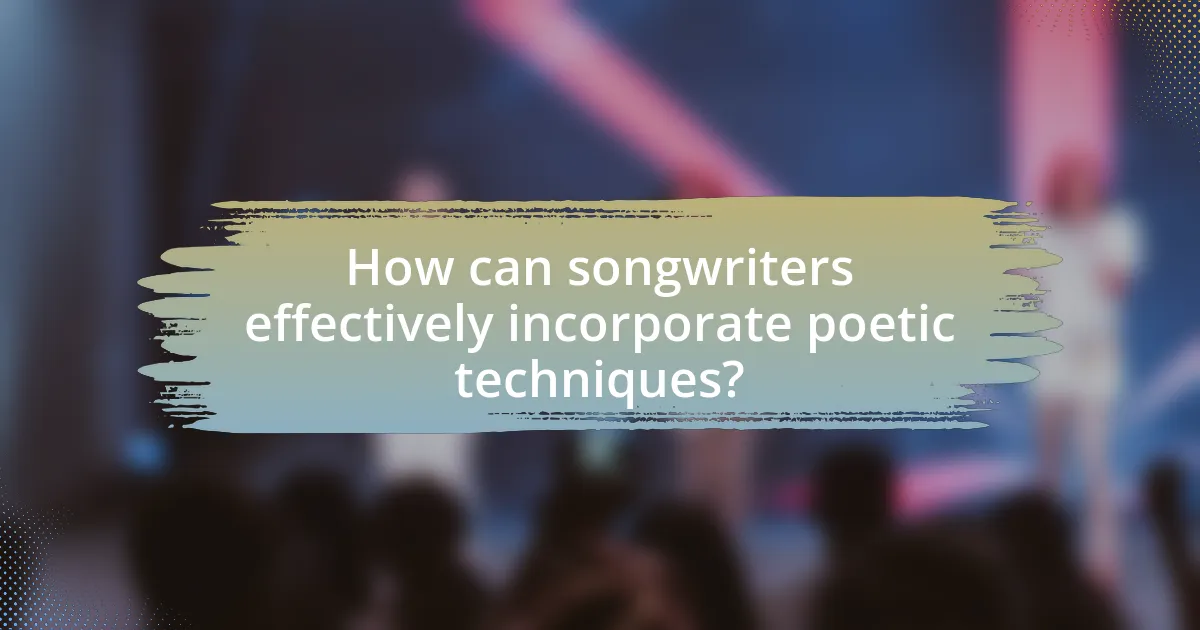
How can songwriters effectively incorporate poetic techniques?
Songwriters can effectively incorporate poetic techniques by utilizing devices such as imagery, metaphor, and rhyme to enhance emotional resonance and lyrical depth. For instance, imagery allows songwriters to create vivid mental pictures that evoke feelings, while metaphors can convey complex ideas succinctly, enriching the narrative. Rhyme schemes contribute to the musicality of lyrics, making them more memorable and engaging. Research indicates that songs employing these techniques often achieve greater listener connection and retention, as seen in the works of artists like Bob Dylan and Leonard Cohen, who are renowned for their poetic lyricism.
What are the best practices for using poetic devices in lyrics?
The best practices for using poetic devices in lyrics include employing imagery, utilizing metaphor and simile, and maintaining a consistent rhythm. Imagery enhances emotional connection by painting vivid pictures in the listener’s mind, making the lyrics more relatable and impactful. Metaphors and similes create deeper meanings and associations, allowing listeners to interpret the song on multiple levels. Consistent rhythm ensures that the lyrics flow well with the music, enhancing memorability and singability. These practices are supported by the fact that many successful songwriters, such as Bob Dylan and Leonard Cohen, effectively use these devices to create compelling narratives and evoke strong emotions in their work.
How can songwriters develop their own unique voice through poetry?
Songwriters can develop their unique voice through poetry by experimenting with diverse poetic forms, styles, and techniques that resonate with their personal experiences and emotions. By engaging with various poetic devices such as metaphor, imagery, and rhythm, songwriters can enhance their lyrical expression and create a distinctive sound. For instance, analyzing the works of poets like Sylvia Plath or Pablo Neruda can inspire songwriters to incorporate vivid imagery and emotional depth into their lyrics, thus differentiating their voice in the music industry. This approach not only enriches their songwriting but also allows for a deeper connection with their audience, as unique poetic elements often evoke strong emotional responses.
What exercises can help songwriters practice poetic techniques?
Songwriters can practice poetic techniques through exercises such as writing daily free verse poems, which encourages creativity and exploration of imagery and metaphor. This exercise allows songwriters to experiment with language without the constraints of rhyme or meter, fostering a deeper understanding of poetic devices. Additionally, analyzing and rewriting existing song lyrics using different poetic forms, such as sonnets or haikus, helps in recognizing structure and rhythm in songwriting. Research indicates that engaging in these practices enhances lyrical skills by promoting a greater appreciation for word choice and emotional resonance, essential elements in both poetry and songwriting.
What challenges might songwriters face when borrowing from poetry?
Songwriters may face challenges such as maintaining lyrical rhythm and melody when borrowing from poetry. Poetry often employs complex structures, varied meter, and intricate rhyme schemes that may not easily translate into the musical format of a song. Additionally, the emotional depth and imagery in poetry can be difficult to condense into concise lyrics that resonate with listeners while fitting within the constraints of a song’s structure. For instance, a poem’s nuanced language might require simplification to ensure clarity and accessibility in a song, which can dilute the original intent or meaning.
How can songwriters avoid clichés while using poetic elements?
Songwriters can avoid clichés while using poetic elements by employing unique imagery and personal experiences to create fresh perspectives. By focusing on specific, vivid details from their own lives or observations, songwriters can craft lyrics that resonate on a deeper level, steering clear of overused phrases. For instance, instead of relying on common metaphors like “love is a battlefield,” a songwriter might draw from a specific memory or emotion, such as the feeling of warmth from a shared moment, which adds authenticity and originality. This approach not only enhances the emotional impact of the lyrics but also distinguishes their work in a saturated market, where originality is crucial for listener engagement.
What strategies can help maintain originality in lyrics?
To maintain originality in lyrics, songwriters can employ strategies such as personal storytelling, unique imagery, and diverse musical influences. Personal storytelling allows artists to draw from their own experiences, creating authentic narratives that resonate with listeners. Unique imagery involves using vivid and unconventional descriptions that evoke strong emotions and visuals, setting the lyrics apart from common themes. Additionally, incorporating diverse musical influences can inspire fresh lyrical ideas, as blending genres often leads to innovative expressions. These strategies are supported by the fact that many successful songwriters, like Taylor Swift and Bob Dylan, have utilized personal experiences and distinctive imagery to craft memorable and original lyrics.

What are the benefits of blending poetry with songwriting?
Blending poetry with songwriting enhances emotional depth and lyrical richness. This combination allows songwriters to utilize poetic devices such as metaphor, imagery, and rhythm, which can evoke stronger emotional responses from listeners. For instance, renowned songwriters like Bob Dylan and Leonard Cohen have effectively integrated poetic techniques into their lyrics, resulting in songs that resonate on multiple levels. Research indicates that songs with poetic elements often achieve greater critical acclaim and listener engagement, demonstrating the tangible benefits of this artistic fusion.
How does this blend enhance listener engagement?
The blend of poetry and song lyrics enhances listener engagement by creating a deeper emotional connection through vivid imagery and rhythmic patterns. This combination allows listeners to experience a more immersive narrative, as poetic techniques such as metaphor and alliteration evoke strong feelings and stimulate imagination. Research indicates that songs with poetic elements can increase memorability and emotional resonance, leading to a more profound listener experience. For instance, a study published in the Journal of Music Psychology found that lyrics employing poetic devices significantly improved listener recall and emotional response compared to straightforward lyrics.
What emotional responses can be evoked through poetic lyrics?
Poetic lyrics can evoke a wide range of emotional responses, including joy, sadness, nostalgia, anger, and introspection. These emotions arise from the use of literary devices such as imagery, metaphor, and rhythm, which create vivid mental pictures and resonate with personal experiences. For instance, a study by the University of California found that lyrics employing strong imagery can significantly enhance emotional engagement, leading listeners to feel more connected to the song’s themes. Additionally, the use of metaphor can deepen the listener’s understanding of complex emotions, allowing for a more profound emotional experience.
How can storytelling in lyrics be improved through poetry?
Storytelling in lyrics can be improved through poetry by incorporating vivid imagery, metaphor, and structured forms that enhance emotional resonance. Poetry often employs techniques such as symbolism and alliteration, which can create deeper connections with listeners. For instance, the use of metaphor allows songwriters to convey complex emotions succinctly, as seen in works by poets like Robert Frost, whose imagery evokes strong feelings and paints clear pictures in the mind. Additionally, structured forms like sonnets or free verse can provide a rhythmic quality that complements musical composition, making the narrative more engaging. This approach is supported by the fact that many successful songwriters, including Bob Dylan and Leonard Cohen, have drawn heavily from poetic traditions, demonstrating the effectiveness of these techniques in enhancing storytelling within lyrics.
What impact does this fusion have on the music industry?
The fusion of poetry and song lyrics significantly enhances the emotional depth and artistic expression within the music industry. This integration allows songwriters to utilize poetic techniques such as metaphor, imagery, and rhythm, which enrich the storytelling aspect of songs. For instance, artists like Bob Dylan and Leonard Cohen have demonstrated how lyrical poetry can elevate music, leading to critical acclaim and commercial success. The incorporation of poetic elements has also been shown to resonate more deeply with audiences, as evidenced by the increased popularity of songs that employ sophisticated lyrical structures, resulting in a broader appreciation for music as an art form.
How do successful artists utilize poetry in their songwriting?
Successful artists utilize poetry in their songwriting by incorporating literary devices such as imagery, metaphor, and rhythm to enhance emotional depth and storytelling. For instance, artists like Bob Dylan and Leonard Cohen often employ vivid imagery and complex metaphors, which allow listeners to connect with the themes on a deeper level. Research indicates that the use of poetic techniques can elevate the lyrical quality, making songs more memorable and impactful. A study published in the Journal of Popular Music Studies highlights that songs with strong poetic elements tend to resonate more with audiences, demonstrating the effectiveness of blending poetry with music.
What trends are emerging in the integration of poetry and music?
Emerging trends in the integration of poetry and music include the use of spoken word and narrative storytelling within songs, as well as the blending of genres that emphasize lyrical depth. Artists increasingly incorporate poetic devices such as metaphor, imagery, and rhythm to enhance emotional resonance in their music. For instance, the rise of hip-hop and indie music has showcased how complex lyrical structures can convey profound themes, reflecting a shift towards valuing literary artistry in songwriting. This trend is supported by the growing popularity of platforms like Instagram and TikTok, where poets and musicians share their work, fostering a community that celebrates the fusion of these art forms.
What practical tips can songwriters use to borrow from poetry?
Songwriters can borrow from poetry by employing techniques such as imagery, metaphor, and structured forms. Imagery enhances emotional resonance by creating vivid pictures in the listener’s mind, similar to how poets use descriptive language to evoke feelings. For instance, using sensory details can make lyrics more relatable and impactful. Metaphors allow songwriters to convey complex emotions and ideas succinctly, as seen in many classic songs that draw on poetic devices to deepen meaning. Additionally, adopting structured forms like sonnets or free verse can help songwriters experiment with rhythm and flow, mirroring the musicality found in poetry. These techniques not only enrich the lyrical content but also engage listeners on a deeper level, demonstrating the strong connection between poetry and songwriting.
